Principle
In this experiment, students are introduced to the basics of acids and bases using everyday examples. In addition to practical work in the laboratory, the significance of different pH values is also discussed.
Benefits
- Digital learning thanks to the free measureAPP: display of measurement data on the tablet and option to export for evaluation to a computer
- Minimal preparation time: experimental literature available for students and teachers
- Simple teaching and efficient learning when using the interactive experiment literature
- Risk assessment available for students and teachers
Tasks
- Handling and, if necessary, calibrating a pH meter (Cobra SMARTsense pH)
- Measuring the pH values of various acids and bases from everyday life, e.g. sparkling water, milk, lemonade or lemon juice
- Classification of the pH values into the "acidic" or "alkaline" environment
- Assignment of the environments to discrete pH value ranges
Learning objectives
- What does a pH meter measure?
- How do everyday chemicals react in water?
- What is an "acidic" or "basic" environment and how does this relate to the concentration of protons (hydronium ions) in water?

